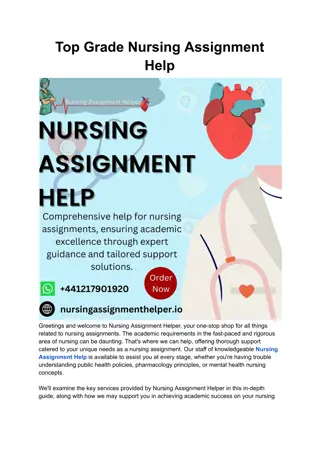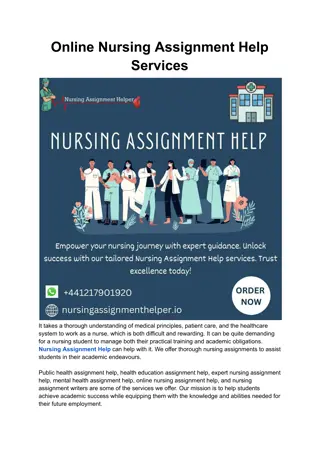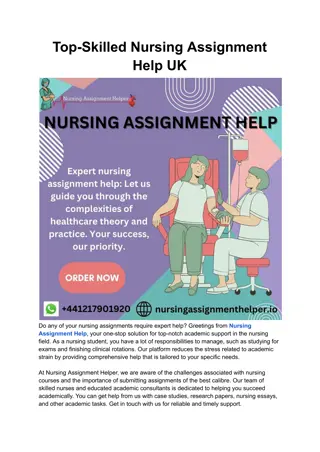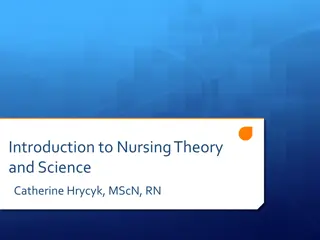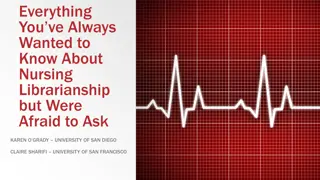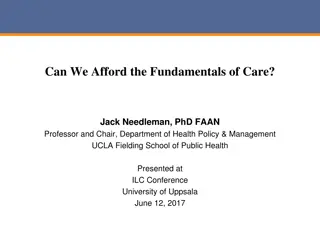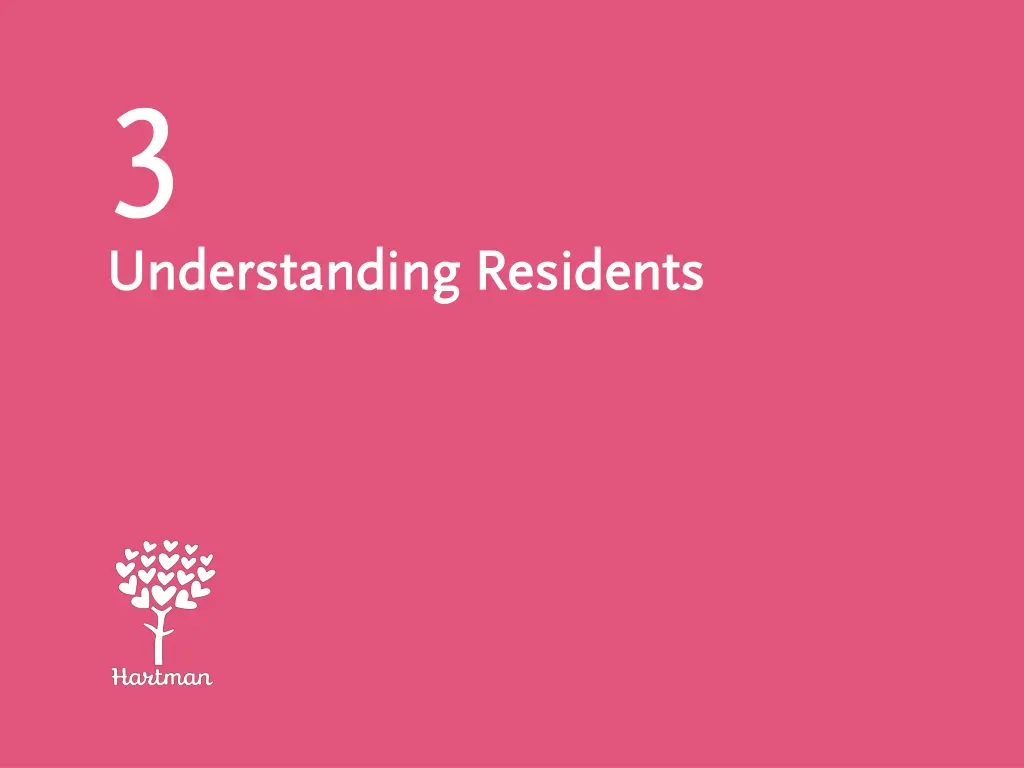
Understanding Residents' Basic Human Needs
Discover the fundamental physical and psychosocial needs of residents, the importance of meeting these needs, and how unmet needs can impact their health and well-being. Explore Maslow's Hierarchy of Needs and reflect on the significance of self-esteem and self-actualization.
Download Presentation

Please find below an Image/Link to download the presentation.
The content on the website is provided AS IS for your information and personal use only. It may not be sold, licensed, or shared on other websites without obtaining consent from the author. If you encounter any issues during the download, it is possible that the publisher has removed the file from their server.
You are allowed to download the files provided on this website for personal or commercial use, subject to the condition that they are used lawfully. All files are the property of their respective owners.
The content on the website is provided AS IS for your information and personal use only. It may not be sold, licensed, or shared on other websites without obtaining consent from the author.
E N D
Presentation Transcript
3 Understanding Residents Understanding Residents
3 1. Identify basic human needs Define the following term: Understanding Residents psychosocial needs psychosocial needs needs that involve social interaction, emotions, intellect, and spirituality. 2
3 1. Identify basic human needs These are the basic physical needs of human beings: Food and water Protection and shelter Activity Sleep and rest Comfort, freedom from pain Understanding Residents 3
3 1. Identify basic human needs Some nursing assistant tasks address residents physical needs, including the following: Understanding Residents Assisting with eating Assisting with elimination Assisting with bathing Assisting with grooming 4
3 1. Identify basic human needs These are six psychosocial needs of human beings: Understanding Residents Love and affection Acceptance by others Safety and security Self-reliance and independence in daily living Contact with others Success and self-esteem 5
3 1. Identify basic human needs When a person s psychosocial needs are not met the response may include Understanding Residents Frustration Stress Fear Anxiety Anger Aggression Withdrawal Depression 6
3 1. Identify basic human needs Think about this question: Understanding Residents How could the strong negative feelings associated with unmet psychosocial needs interfere with residents health? 7
3 Transparency 3-1: Maslow s Hierarchy of Needs Understanding Residents 8
3 1. Identify basic human needs Think about these questions: Understanding Residents What do self-esteem and self-actualization mean to you? Which of the needs in Maslow s Hierarchy of Needs are physical? Which are psychosocial? Are any of the needs more important than the others? 9
3 1. Identify basic human needs Define the following term: Understanding Residents masturbation masturbation to touch or rub sexual organs in order to give oneself or another person sexual pleasure. 10
3 1. Identify basic human needs REMEMBER: Understanding Residents Respect and privacy are very important when encountering any sexual situation. 11
3 1. Identify basic human needs It is important for NAs to remember the following about residents sexual needs and sexual situations: Understanding Residents People continue to have sexual needs throughout their lives. Humans express their sexuality through different behaviors. Knock and wait for a response before entering residents rooms. Provide privacy if you encounter a sexual situation. Be open and nonjudgmental. Respect residents' sexual orientation and gender identity. Use the pronouns and names that transgender residents wish to use. 12
3 1. Identify basic human needs It is important for NAs to remember the following about residents sexual needs and sexual situations (cont'd): Understanding Residents Respect residents sexual orientation. Honor Do Not Disturb signs. Do not view expressions of sexuality by elderly as cute or disgusting. 13
3 Handout 3-1: Myths About Older Adults and Sexuality Myth #1: Older men are not capable of having sexual Myth #1: Older men are not capable of having sexual relations. relations. There are some physical changes that may alter the way a couple engages in sexual relations. Men may need more direct contact, may take longer, and may need longer between sexual activities to perform again. However, many men continue to have satisfying relations well into old age. Myth #2: After menopause women are not interested in sexual Myth #2: After menopause women are not interested in sexual relations. relations. Many women relax and enjoy sex more in later years. With no fear of pregnancy, many women feel much freer. There may be some physical changes, such as less lubrication, but there are remedies available. Communication with their physicians is important. The reason many older women stop having sex is because they lose their partners when their partners die. Understanding Residents 14
3 Handout 3-1: Myths About Older Adults and Sexuality (cont d) Myth #3: Any expression of sexuality by older people is either Myth #3: Any expression of sexuality by older people is either disgusting or cute. disgusting or cute. This attitude deprives older people of their right to dignity and respect. Older adults have the same needs and rights to express their sexuality as other age groups, and they may do so in the same ways. In all age groups there is a wide variety of behavior. This is also true of older people. It is true, however, that our society discourages this expression by the messages sent through jokes, advertisements, and the media. Older people see and hear these messages and may believe that there is something wrong with them if they feel or act on their desires. Understanding Residents 15
3 1. Identify basic human needs REMEMBER: Understanding Residents Residents must be protected from unwanted sexual advances. If an NA sees sexual abuse happening, he should remove the resident from the situation and take the resident to a safe place. He should then report to the nurse immediately. 16
3 1. Identify basic human needs NAs can help residents meet their spiritual needs in these ways: Understanding Residents Learn about their religions or beliefs. Respect residents decisions to participate in, or refrain from, food-related rituals. Encourage participation in religious services for residents who are religious. Respect all religious items. Report requests to see clergy to nurse. Allow privacy for clergy visits. If asked, read religious materials aloud. Refer resident to spiritual resources if requested. 17
3 Transparency 3-2: Not Permitted The following are not permitted regarding residents' spiritual/religious needs: Understanding Residents Trying to change someone s religion Telling residents their belief or religion is wrong Expressing judgments about a religious group Insisting that residents join religious activities Interfering with religious practices Discussing your personal beliefs or opinion either directly or indirectly 18
3 1. Identify basic human needs Think about these questions: Understanding Residents Why should you not be judgmental about other people s beliefs? Why should you not impose your beliefs on your residents? Would your political ideas be appropriate topics of conversation with your resident or his family? What are some appropriate topics of conversation with residents and their families? 19
3 2. Define holistic care Define the following term: Understanding Residents holistic care holistic care a type of care that involves caring for the whole person the mind as well as the body. 20
3 2. Define holistic care Think about this question: Understanding Residents Can you think of an example of how NAs can provide holistic care to residents? 21
3 3. Explain why promoting independence and self-care is important Residents in LTC facilities may be experiencing any of these losses: Understanding Residents Loss of spouse, family, or friends Loss of workplace and its relationships Loss of ability to go places Loss of ability to attend services and meetings at their faith communities Loss of home and personal possessions Loss of health and ability to care for themselves Loss of ability to move freely 22
3 3. Explain why promoting independence and self-care is important Residents in LTC facilities may be experiencing any of these losses (cont'd): Understanding Residents Loss of pets LGBTQ residents may fear the loss of a comfortable or accepting environment 23
3 3. Explain why promoting independence and self-care is important Loss of independence can cause: Understanding Residents Poor self-image Anger Feelings of helplessness, sadness, and hopelessness Feelings of uselessness Increased dependence Depression 24
3 3. Explain why promoting independence and self-care is important NAs promote independence in residents when they do the following: Understanding Residents Encourage residents to do as much as possible for themselves, no matter how long it takes. Be patient. Allow residents to make choices. 25
3 3. Explain why promoting independence and self-care is important REMEMBER: Understanding Residents It is important that NAs never treat residents like children. Residents are adults who can make their own choices and should care for themselves as independently as possible. 26
3 4. Identify ways to accommodate cultural differences Define the following term: Understanding Residents cultural diversity cultural diversity the different groups of people with varied backgrounds and experiences who live together in the world. 27
3 4. Identify ways to accommodate cultural differences Culture plays a part in determining all of the following: Understanding Residents Language Religion Food preferences Touch 28
3 Handout 3-2: Religions and Dietary Practices Understanding a little bit about common religious groups may be useful. Common religions, listed alphabetically, follow: Understanding Residents Buddhism: Buddhism: Buddhism started in Asia but has many followers in other parts of the world. Buddhism is based on the teachings of Siddhartha Gautama, called Buddha. Buddhists believe that life is filled with suffering that is caused by desire and that suffering ends when desire ends. Buddhism emphasizes meditation. Proper conduct and wisdom release a person from desire, suffering, and a repeating sequence of births and deaths (reincarnation). Nirvana is the highest spiritual plane a person can reach. It is the state of peace and freedom from worry and pain. There are many Buddhist texts. The Tipitaka or Pali Canon is the standard scripture collection. The Dalai Lama is considered to be the highest spiritual leader. 29
3 Handout 3-2: Religions and Dietary Practices (cont d) Christianity: Christianity: Christians believe Jesus Christ was the son of God and that he died so their sins would be forgiven. Christians may be Catholic or Protestant. There are many subgroups or denominations (such as Baptist, Episcopalian, Evangelical, Lutheran, Methodist, Mormon, Presbyterian, and Roman Catholic). Christians may be baptized and may receive communion as a symbol of Christ's sacrifice. They may attend church on Saturdays or Sundays. Some Christians may try to share their beliefs and convert others to their faith. The Christian Bible is the sacred text and is divided in to the Old Testament and the New Testament. Religious leaders may be called priests, ministers, pastors, preachers, or reverends. Understanding Residents 30
3 Handout 3-2: Religions and Dietary Practices (cont d) Hinduism: Hinduism: Hinduism is the dominant faith of India, but it is practiced in other places as well. According to Hindu beliefs, there are four purposes of life: acting morally and ethically (Dharma), pursuing prosperity (Artha), enjoying life (Karma), and accomplishing enlightenment (Moksha). People move through birth, life, death and rebirth. How a person moves toward enlightenment is determined by karma. Karma is the result of actions in past lives and actions in this life can determine one's destiny in future lives. Hindus advocate respect for all life, and some Hindus are vegetarians. Hindus who do eat meat almost always refrain from eating beef. Hindus follow the teachings of ancient scriptures like the Vedas and Upanishads, as well as other major scriptures. Holy men are called Sadhus. Understanding Residents 31
3 Handout 3-2: Religions and Dietary Practices (cont d) Islam: Islam: Muslims, or followers of Mohammed, believe that Allah (the Arabic term for God) wants people to follow the teachings of the prophet Mohammed. Many Muslims pray five times a day facing Mecca, the holy city for their religion. Muslims also fast during a month-long observation called Ramadan. Muslims worship at mosques and do not drink alcohol or eat pork. There are other dietary restrictions, too. The Qur'an (Koran) is the sacred text of Islam. Islamic religious leaders may be called ayatollah, caliph, imam, mufti, or mullah, among other titles. Understanding Residents 32
3 Handout 3-2: Religions and Dietary Practices (cont d) Judaism: Judaism: Judaism is divided into Reform, Conservative, and Orthodox movements. Jewish people believe that God gave them laws through Moses in in the form of the Torah (the sacred text), and that these laws should order their lives. Jewish services are held in synagogues or temples on Friday evenings and sometimes on Saturdays. Some Jewish men wear a yarmulke, or small skullcap, as a sign of their faith. Some Jewish people observe dietary restrictions. They may not do certain things, such as work or drive, on the Sabbath day (called Shabbat), which lasts from Friday sundown to Saturday sundown. Religious leaders are called rabbis. Understanding Residents 33
3 Handout 3-2: Religions and Dietary Practices (cont d) Spirituality concerns a person s beliefs about the spirit or the soul. It may center on how a person relates to his community, to nature, or to the divine. It may involve reflection and contemplation and a search for inner peace. It may elate to a person's beliefs about the meaning of life. Spiritual practices can include meditation or prayer, but spirituality does not have to encompass religious beliefs. Many people consider themselves to be spiritual but not religious. Many Native Americans (American Indians) follow many different spiritual traditions and practices. An emphasis is placed on the personal and the communal, rather than the institutional, and there is a deep connection with nature. There are many varied practices and rituals. Understanding Residents 34
3 Handout 3-2: Religions and Dietary Practices (cont d) Some people may not believe in God or a higher power and identify themselves as agnostic. Agnostics claim that they do not know or cannot know if God exists. They do not deny that God might exist, but they feel there is no true knowledge of God s existence. Atheists are people who believe that there is no God. This is different from what agnostics believe. Atheists actively deny the existence of any deity (higher power). For many atheists, this belief is as strongly held as any religious belief. Understanding Residents 35
3 Handout 3-2: Religions and Dietary Practices (cont d) Many religious beliefs include dietary restrictions. These are rules about what and when followers can eat. Some examples are listed below. Many Buddhists are vegetarians, though some include fish in their diet. Some Christians, particularly Roman Catholics, do not eat meat on Fridays during Lent. Many Jewish people eat kosher foods, do not eat pork, and do not eat lobster, shrimp, and clams (shellfish). Kosher food is food prepared in accordance with Jewish dietary laws. Kosher and non- kosher foods cannot come into contact with the same plates. Jewish people who observe dietary laws may not eat meat products at the same meal with dairy products. Mormons may not drink alcohol, coffee, or tea. They may not use tobacco in any form. Understanding Residents 36
3 Handout 3-2: Religions and Dietary Practices (cont d) Muslims do not eat pork and may avoid certain birds. They may not drink alcohol. Muslims may have regular periods of fasting. Fasting means not eating food or eating very little food. Some people are vegetarians and do not eat any meat for religious, moral, or health reasons. Some people are and do not eat any animals or animal products, such as eggs or dairy products. Vegans may also not use or wear any animal products, including leather. Understanding Residents 37
3 4. Identify ways to accommodate cultural differences In small groups, ask each other these questions: Understanding Residents Where did you grow up? Did you like it? What kinds of food were served at your house? What languages do you know? 38
3 4. Identify ways to accommodate cultural differences Think about this question: Understanding Residents How can knowing about the residents she cares for help an NA do a better job meeting their needs? 39
3 4. Identify ways to accommodate cultural differences REMEMBER: Understanding Residents NAs should focus on compassionate, respectful, and culturally- sensitive care. They should treat residents as the residents wish to be treated, not as the NA would want to be treated. This is part of person- centered care. 40
3 5. Describe the need for activity Physical activity has the following positive effects: Understanding Residents Lessens risk of illnesses Relieves symptoms of depression Improves mood and concentration Improves body function Lowers risk of falls Improves sleep Improves ability to cope with stress Increases energy Increases appetite 41
3 5. Describe the need for activity Inactivity can cause the following problems: Understanding Residents Loss of self-esteem Anxiety Depression Boredom Pneumonia Urinary tract infection Skin breakdown and pressure ulcers Constipation Blood clots Dulling of senses 42
3 6. Discuss family roles and their significance in health care There are many different family types, including the following: Understanding Residents Nuclear families Single-parent families Married or committed couples of the same sex or opposite sex Extended families Blended families 43
3 6. Discuss family roles and their significance in health care Families may participate in the care of residents in these ways: Understanding Residents Helping to make care decisions Communicating with care team Giving support and encouragement Connecting to outside world Giving assurance to dying residents 44
3 6. Discuss family roles and their significance in health care REMEMBER: Understanding Residents Residents families are likely experiencing significant adjustments. NAs should be respectful. They should allow privacy for visits and observe and report the effect of visits on residents. 45
3 6. Discuss family roles and their significance in health care REMEMBER: Understanding Residents NAs should take the time to ask families questions. NAs should communicate with families and show them that NAs have time for them. 46
3 7. Describe the stages of human growth and development Infancy (Birth to 12 months) Understanding Residents Grow and develop quickly Development is from head down 47
3 7. Describe the stages of human growth and development Toddlerhood (Ages 1 to 3) Understanding Residents Formerly dependent, now gaining independence and body control Learn to speak, gain coordination, and bladder and bowel control May have tantrums or whine to get their way 48
3 7. Describe the stages of human growth and development Preschool Years (ages 3 to 6) Understanding Residents More social relationships Play cooperatively and learn language Learn right from wrong 49
3 7. Describe the stages of human growth and development School-Age years (Ages 6 to 10) Understanding Residents Cognitive development (thinking and learning) Learn to get along with others in their peer group Develop a conscience and self-esteem 50







